A. FR. ARNOLD AND THE MEANS OF COMMUNICATION IN HIS TIME
I have been asked to speak about how and why Fr. Arnold took advantage of the means of communication available at his time.
Looking at his life we see that he began his work as a communicator as promoter and director of the Apostleship of Prayer.
I. Media in the service of the Apostleship of Prayer
For most of his life Fr. Arnold was in the business of communication; actually his involvement in communication started with his work as promoter and diocesan director of the Apostleship of Prayer. And there he was a most successful communicator. He supported his work in the service of the Apostleship through little booklets and prayer leaflets.
Altogether he published and sold about 400000 prayer booklets and leaflets in the service of the Apostleship of Prayer. All the expenses for the publications he paid himself.
Even after Fr. Arnold had founded the mission house in Steyl; he continued publishing little prayer booklets – like a St. Joseph Booklet in 1884 with prayers to St. Joseph. In 1908 a 12th edition of this booklet was published.
Another special prayer leaflet from before the foundation of Steyl which was spread all over German speaking Europe explained the prayer of the rosary and suggested five special intentions, one for each of the five decades. The reasoning behind the idea was quite simple. The rosary is one of the most familiar of all Catholic prayers both in the parish community and at home. If the faithful are taught to be aware of the needs of others in their prayers, they will be less preoccupied with their own selfish interests, and by degrees will acquire a selfless concern for others, a sincere love of neighbor.
When we look at these intentions we see they were truly in the service of evangelization:
The five intentions were not directly related to the mysteries as such. For the first decade the intention was “the extension of God’s love and kingdom on earth.” The second was for missionaries, priests and bishops of the Holy Church, that the Lord may bless them and fill them with zeal for the salvation of souls. The third intention was for the conversion of sinners, the consolation of the afflicted, assistance to the needy and oppressed, and for progress of virtue in the just. The fourth “for God’s blessing on families, communities, institutions and houses of religious, that all may serve God in peace and gain eternal happiness.” The fifth -“for the triumph of God’s cause over its enemies everywhere, and that the erring may be brought back to the bottom of the holy church.”
Our late historian Fr. Bornemann writes: Through his efforts to promote the Apostleship of Prayer and selfless intercession through the rosary, and by his own prayer for the great intentions of the Church, the school teacher in Bocholt had developed a truly catholic [worldwide, universal] outlook. (Bornemann, transl. John Vogelgesang, Arnold Janssen, Manila, 1975, p. 35).
II. THE LITTLE MESSENGER OF THE SACRED HEART
- Reason for founding the magazine
Fr. Arnolds work in the service of the Apostleship had made him more and more dissatisfied with teaching in little Bocholt. He was interested in the whole world. Publishing successfully so many small booklets and prayer leaflets had given him a taste for communication.
In 1873 he decided to quit his work as a high school teacher. And his new ambition in life was:
“I was imbued with the idea of doing more for the spiritual welfare of the Church and especially the foreign missions. But because of the heavy schedule and in particular the subjects I had to teach (science, physics, mathematics and French), there was little opportunity for these activities. I wanted to take up a position where I could do this; that meant giving up the job in Bocholt. My intention in particular was to find the time to publish a popular monthly for promotion of prayer and participation in the great intentions of the Divine Savior, especially the propagation of faith (Alt, Journey in Faith, p. 41), that is evangelization. He wanted to become a full time evangelizer through the media.
After some searching he ended up as chaplain and part-time teacher with the Ursuline Sisters in Kempen, the home of famous Thomas of Kempen, the author of the Imitatio Christi.
- Fr. Arnold the editor, writer, sales manager, accountant
And here in Kempen he became a full time evangelizer through communication – his communication enterprise was a one man enterprise. He was a writer, editor, sales manager. The magazine was printed in Paderborn. He called his magazine Kleiner Herz-Jesu-Bote; He had borrowed the name from the magazine of the Apostleship of Prayer: Messenger of the Sacred Heart. He just added the word “Little” –Little Messenger of the Sacred Heart.
Each issue would consist of eight pages in an eight by twelve inch, two column format with a map or a picture. Fr. Arnold was the owner of the magazine, therefore all the profit went to him and he also earned his livelihood, for he had no fixed income.
He told the printer and publisher to place large and expensive adds in the three major German Catholic newspapers, and smaller adds in a dozen small papers, mostly in Germany, but also in Tirol and Vienna.
He wrote three promotional letters which the printer was to send to priests, religious houses and book dealers. 2700 copies of these letters were mailed out.
As I said in the other talk, the content focused on the foreign, the pagan missions from the second issue on.
In order to find material for the magazine which was to appear monthly he studied many books and maps. He studied mission history and subscribed to a French catholic mission magazine, the foremost publication of the French Society of the Propagation of faith, founded by Pauline Jaricot, a French lay woman.
Fr. Arnolds little magazine was not the only mission magazine in Germany, but the Jesuits published one as well, already since 1873. It was intended for the clergy and highly educated lay people.
Fr. Arnold aimed at the broad mass of the people. After three months he had 3000 subscribers. After paying all the expenses, he still made a small profit, so he could pay for the next issue.
- Style of the magazine
When we look at the style of his magazine we see: He wrote simply, factually, and without fine phrases. And he gave witness of his faith which radiated from every page of the magazine. The result was that his readers staunchly supported him and his work. He himself wrote about his style: My guiding principle is always to be as intelligent and interesting as possible.
The titles of the articles were meant to attract the reader. The articles contained detailed information about geographical data, flora, fauna and ethnology. Against this background he drew a clear picture of the life of the missionary. Everything was condensed, almost as in an encyclopedia.
Now and then he printed a few dogmatic ascetic articles which went about the head of his readers.
Each issue began with a prayer before reading and ended with a prayer after reading. Some people thought he was overdoing it, but he said: If I only please God the Lord, it will be alright.
With his articles he sought to awaken in his homeland interest in the foreign, the pagan missions as well as in well as in the needs of his homeland.
- A special missionary supplement: The Living Rosary leaflet
Together with the magazine he published each month a four-page leaflet for the LIVING ROSARY which had been started in France by Pauline Jaricot. The leaflet contained intentions for the 15 decades of the rosary. The decades were assigned to 15 persons, each of whom promised to pray a decade of the rosary daily and was given a new prayer intention each month.
These rosary leaflets were not added to the magazine as something extra, but formed a single unit with it. He wrote: We promote the missions most effectively by getting the people to pray fervently for them. It is a question of converting the world. The world will be converted if God wills it. God wills it as soon as grace for it is implored. Clearly, a great grace cannot as rule be obtained except through much prayer. “General admonitions to pray are good and useful. Much more effective, however, is practical direction.” He wanted the directions to be as simple as if they were meant for children. “In a certain sense we remain children all our life. We are most helpless precisely in those things that are most important, prayer, for example.”
The intentions for the decades covered the whole world, Christian and non-Christian countries alike. Furthermore, he gave statistical data about the religious condition in each country as well as details about the land and the people. There was a saint for each month, a list of the saints of the country and a litany – like series of petitions for the various countries and for the person saying the prayers. “Such prayer is real prayer for the missions,” he said; “it widens the spiritual vision of all sides.”
Within a year he had 800 subscribers for the rosary leaflets; gradually the total climbed to 1000. Even 20 years later he still published the LIVING ROSARY SUPPLEMENT.
Fr. Arnold handed his work as editor of the magazine over to Fr. Wegener in 1877. He had a polished style and offered a wider range of topics.
Fr. Arnold was well aware of the contribution the Little Messenger had made in the founding of the Steyl mission organisation. And he said clearly, without it, he would not have been able to do so much in such a short time!
III. THE FIRST PRINTING PRESS
In 1874 and 1875 the Little Messenger was printed in the St. Boniface printing press in Paderborn. But in 1875 Fr. Arnold was informed that the contract with him was not going to be renewed at the end of the year. So Fr. Arnold decided to have his own printing press which started work on January 27, 1876. Fortunately he had found a volunteer trained lay printer. At the blessing of the press Fr. Arnold said:
‘Our divine savior pointed to the word for the conversion of the world by saying: “Preach the gospel to all creatures”. At his time the printed word was not known. At present it is known, it is practiced and the devil uses it to do a lot of bad things with it. The servant of Jesus, therefore, must use it to do good with it. For how powerful the printed word is which through the press in an hour’s time is multiplied a thousandfold! However, not the multitude of printed matters is important. What is important is that the word is being read and put into practice. … (auf der Heide, Die Missionsgesellschaft von Steyl (The Mission Society of Steyl), p. 58).
After the blessing Fr. Arnold ran off the first page of the January issue of the Little Messenger.
IV. THE HEILIGE STADT GOTTES (HOLY CITY OF GOD)
The publication of this magazine was the result of an offer made by a most successful Dutch publisher from Hertogenbosch in the Netherlands. He was especially good at printing pictures. And he proposed to Fr. Arnold a pictorial family magazine for German – speaking readers.
The offer took Fr. Arnold completely by surprise. Was such a magazine compatible with the missionary program of the mission house (overseas missions)? He himself recalled later:
“We were at first rather opposed to the whole idea. One of the main reasons was that Germany already had several illustrated magazines.” But finally he accepted the offer. He reasoned like this: By means of a non – mission magazine the seminary and its press would be able to bring the mission idea to circles that were otherwise not easy to reach. And the offer was financially attractive. The seminary might derive a modest income for itself instead of being completely dependent on donations.- In the course of time the whole SVD got financial support from the Steyl mission printing enterprise!
The magazine was typeset in Steyl and then sent to Hertogenbosch where it was printed with pictures. It was an 8 page weekly in such a large format that it could not be printed in Steyl. But for five years it was printed in Hertogenbosch.
The first issue appeared on January 6, 1878. The title “Holy City of God” could have been inspired by St. Augustine’s City of God or from THE MYSTICAL CITY OF GOD, by a 17th century visionary and nun, Maria of Agreda.
In the first issue Fr. Arnold explained to his readers how a mission house whose main task were foreign missions could publish a family magazine for Germany.
He wrote:
“Whoever wants to spread something good he / she must intend to influence his fellow human beings. And he then must use those means which according to the situation at a given time seem to be the most appropriate ones. The press is today one of those means.”
By publishing the “Stadt Gottes” Fr. Arnold, in his own words, wanted to do something more than had happened so far in order to influence the public spirit in Germany for the best of holy religion.
The (missionary) goal of the “Stadt Gottes” was the same as the goal of the St. Paul’s Association in Switzerland for the promotion of a good press:
“That the views of our faith would rule more and more in the state, in the family and in the life of the individual person.”
The “Stadt Gottes” will reach that goal through three kinds of articles. Again in the first issue of the Stadt Gottes we read:
- The Stadt Gottes wants to be an entertaining magazine. Therefore it strives to bring good stories and novels, beautiful engravings and drawings from daily life as well as from daily – and war history; it will bring something of those many things which are suitable to spend an hour of leisure in a pleasant and if possible instructive way.
- The “Stadt Gottes” will also be an instructive magazine for the purpose of spreading useful knowledge, particularly from that exalted temple of God, which nature is. God has placed us there so that nature will proclaim to us His existence, his greatness, his wisdom and all his exalted qualities.
- The “Stadt Gottes” will also be a religious magazine, that means it will give inspiration and teaching also in religious matters, and in this regard it wants to do a bit more than the already existing illustrated weekly magazines do.
For his new magazine Arnold Janssen needed the help of writers and poets. In order to attract their cooperation he invited them in an article in the second issue of the Stadt Gottes to send in their novels or poems or whatever. They did not have to be religious, but must not oppose the Christian spirit of the magazine. Even good jokes were welcome.
Fr. Arnold concludes this article with the words which could be considered the mission statement of the “Stadt Gottes”:
“Dear Holy Stadt Gottes (City of God), now you may begin your wandering into all the regions of Germany. May the Lord and his dear mother help that you become a faithful fighter for truth and justice, and that you preserve in many hearts also the love for holy religion and the great creator of all hearts. …” (p. 15).
VI St. MICHAEL’S ALMANAC
The publication of this magazine, the eventually most successful of his publications, the real bread winner, was suggested to Fr. Arnold by another layman, Dr. Kolbe from Berlin. He then became also the first editor in chief for five years.
The Almanac appeared once a year in German and in Dutch; it contained interesting information, novels, and also for each day of the year it gives information about the sunrise and sunset, moonrise and moonset, the stars. It gave liturgical information, spiritual inspiration- and all of that on one page. Each month had its own page- with the just mentioned information for each day.
This calendar had a circulation of 500,000 in 1900. In it we also find the first advertisement of the founding of your motherhouse and congregation:
A short while ago a house has been founded also for missionary sisters. Those are sisters who will be active in the house in Steyl. Later on they will also work in the foreign missions and there they will in particular work for women. This new house for the sisters will be under the direction of St. Michael’s mission house.
Besides the already mentioned missionary sisters some sisters will be accepted into the house who see it as their vocation to be in greater seclusion active in women’s activities and to pray with special zeal for the missions and the overall task of the society to God the Holy Spirit whose adoration and veneration we particularly promote.
VII PUBLISHING HOUSE
In 1880 the Mission press also branched out into book publishing. Its 1885 catalogue listed a dozen brochures from 16 to almost 100 pages and as many books with 150, 300 and 500 pages. These included historical narratives, several biographies, ascetical literature and devotional books. From 1895 on 15 to 20 new titles were added each year.
All of this was in the service of evangelization as well as a sound financial footing of the mission house.
VIII A SPECIAL PUBLICATION IN HONOR OF THE HOLY SPIRIT
During the 1884-1886 SVD general chapter the Society decided on emphasizing in a very special way the devotion to the Holy Spirit.
In honor to promote the devotion to the Holy Spirit to the readers of his mission magazine “Kleiner Herz-Jesu-Bote”, Little Messenger of the Sacred Heart, Fr. Arnold began with the publication of a 4 page publication, called “Komm, Heiliger Geist, hernieder!” – Come down, Holy Spirit. Fr. Arnold himself published it, writing articles himself or selecting others for publication. These publications were thought as supplements to the Little Messenger of the Sacred Heart. The first one was published Pentecost 1887. And then the issues appeared in irregular intervals until June 1908.
B. THE INFLUENCE OF FR. ARNOLD’S COMMUNICATION APOSTOLATE ON THE DEVELOPMENT OF THE CONGREGATIONS FOUNDED BY HIM
I. MISSION ANIMATION – PUBLICISING THE FOUNDATION OF THE MISSION HOUSE – VOCATION – FINANCES
Naturally, Fr. Arnold wanted first of all the missionary apostolate of the church to be known; the Little Messenger did mission animation. And then he wanted to get his foundations known and solicit donations for them.
With regard to the development of St. Michael’s mission house he kept his reading public well informed about its spiritual and physical development- which, so I guess, gave him the support of his readers, also financial support. Let us follow, therefore, this development from the beginning until September 8, 1875.
- From decision to completion (September 1874-September 1875)
The slowly unfolding story of the foundation
a. general information
Fr. Arnold gave his information in a way which was particular to him. In the second issue of the Little Messenger of the Sacred Heart from February 1874 he wrote in a footnote: it necessarily belongs to God’s guidance that he reveals his plans only gradually.
In his articles concerning the foundation of the mission house Fr. Arnold went about in exactly that way: He let his readers participate in the way how God led him gradually in understanding what God wanted him to do: first he informed his readers only in a very general way- and gradually, as he recognized God’s plans more and more so his information about the foundation of the mission house became more concrete. How did Fr. Arnold come to make his decision to start a mission house? Responsible for that was the Apostolic Prefect of Hong Kong, Raimondi. Pentecost 1874 he had been visiting the parish priest of Neuwerk near Mönchengladbach, Msgr. Dr. von Essen, who was interested in starting a mission house for China missionaries. Wanting to get some information about China for the Little Messenger Fr. Arnold visited and interviewed Raimondi in Neuwerk. When Fr. Arnold said it was said that Germany had no mission house for the foreign missions Raimondi pointed out to him that von Essen wanted to start one and he, Janssen, should team up with him. Yet Janssen refused. Raimondi then visited Arnold Janssen in Kempen.
b. decision to found the mission house
During his visits in Kempen, Raimondi suggested to Fr. Arnold to start an apostolic school, that is a school which trains missionaries from the first year of highschool through philosophy and theology until ordination. After prayerful and thorough discernment about God’s will for him, Fr. Arnold was convinced in September 1874 that God had led him in his life in such a way that he was the right man to start such an apostolic school to train missionaries. God had seen to it that as a teacher he had gathered all the necessary experience to begin with such an Apostolic School. Let us now follow him in his communication of the unfolding foundation of the mission house.
c. September and November 1874: articles about a future mission house
As I said, he had made his decision to start a mission house in September 1874. That very month he reprinted an article by Dr. von Essen in Neuwerk (the host of Raimondi) about the necessity of founding a mission house.
In November 1874 he writes his own ideas about starting a German mission house for German missionaries. And he already makes his first fundraising. He writes:
We ask our pious readers to help with prayer and loving donations as much as they could. It is true, to be pious means to pray piously; but also to work piously with the received talents, as far as the [economic] situation allows it. In a footnote he writes: “If somebody wants to entrust us donations of money for this purpose, we will be happy to accept them. If nothing comes out of the foundation, we will put the money in the bank with interest.”
d. the name of the new mission house / first donations
In January 1875 he writes about the first donations for the new mission house, which he now calls the German – Austrian mission house- it was meant for Germany and Austria.. The donations came from Germany and Austria – from all those places where the Little Messenger was distributed and read.
e. February /March / April 1875: articles explaining an APOSTOLIC SCHOOL
Msgr. Raimondi had suggested to him to train his missionaries from first year of high school through philosophy and theology to ordination. Such schools were called APOSTOLIC SCHOOLS. Wanting to follow that suggestion, Fr. Arnold wrote articles explaining such apostolic schools and their value for the training of missionaries in February, March and April 1875.
f. March 1875 Information about the location and name of the mission house
In March 1875 he also informed his readers that because of the Kulturkampf [cultural war] the mission house should be founded in the Netherlands and that he had already contacted the Bishop [of Roermond]. Furthermore he wrote that the mission house should have St. Michael as patron saint.
g. April / June 1875: Articles about St. Michael the Archangel
So in April and June 1875 he wrote an article each about St. Michael.
h. May 1875 new name of the Mission house and prayer to Mary for the planned new mission house
In May 1875 he published a prayer to Mary for the new mission house which in this month for the first time is called “GERMAN – AUSTRIAN – DUTCH MISSION HOUSE for foreign missions in connection with a training place for educating future missionaries.” Furthermore he mentions with name the bishops who already had given their support for it.
Happily he reported about the blessing of Pope Pius IX for the new mission house.
i. July 1875: Report about the signing of the sales contract for the mission house in Steyl Train connections and timetable for reaching the mission house
In July 1875 he reported that the contract about buying the new mission house for Germany, Austria and the Netherlands had been signed on June 16. He also described very clearly how people could come by train from Germany to Kaldenkirchen, Venlo and finally to Steyl. He even gives the train schedules – arrival in Venlo, coming from various train centres in Germany and departure from Venlo to those same centres.
j. August 1875 report about the spiritual foundation of the new mission house
In August 1875 he wrote about the spiritual foundation of the new mission house:
Fr. Arnold reported to the readers of his magazine Little Messenger of the Sacred Heart that he and his first co-workers had consecrated themselves to the work of the new mission house on June 16, 1875 – the anniversary of the apparition of the Sacred Heart of Jesus to Margaret Mary Alacoque and that on that day the contract about buying the mission house had been made. He wrote:
The mission house will never forget about this its origin. According to its purpose the mission house is directed towards working for the fulfillment of the graceful intentions of the divine Sacred Heart of Jesus. Therefore this origin admonishes it to express this still more clearly with the explicit mentioning of the Sacred Heart of Jesus. In order to prove that the mission house will work for the fulfillment of the intentions of the Sacred Heart it chooses as its motto the following beautiful words: Vivat cor Jesu in Cordibus Hominum – May the Heart of Jesus live in the hearts of all people.
k. September 1875: Report about the opening of the mission house /requirements for acceptance as student
In September 1875 he reported about the opening and the of the mission house on September 8. He published also all the requirements for acceptance as a student .For instance each candidate had to make the following declaration which showed clearly which qualities a missionary had to have:
Those who wanted to become missionaries had to send in application papers. In their application the candidate had to declare “which magazines he had read about the work of missionaries amongst pagan peoples, since when he had the wish to become a missionary, how often and for how long he had been sick, if he felt able for the sake of God to put up with heat, cold and other sufferings and deprivations, and if he was prepared to submit himself to all the laws of the mission house and to train himself in prayer, in obedience and patience in order to become with the grace of God a good missionary.”
After the opening of the mission house, Fr. Arnold kept informing his readership also about the then following development- about the new buildings, about the increase in the number of students- later about the various missions and the work of his missionaries: priests,brothers and sisters.
Very important was for him to give at the end of the Little Messenger a monthly account of the donations he had received.
II: INVOLVEMENT OF THE LAITY
Through the many small donations and two larger ones (a dowry of a Poor Claire Sisters and the donation of an elderly lady who had worked as a domestic worker and received some money from her employers) the laity was involved in the founding of the new mission house and in supporting it in the first years.
But gradually it was seen that the financing needed some more regular income. And that was one reason to start the mission house owned printing press and the Holy Stadt Gottes as well as St. Michael’s Almanac. Both magazines were inspired by two lay men.
The subscriber list for the three Steyl publications increased with the arrival of Bro Clemens Lanze in 1884.
He invented the system of the travelling brothers and the voluntary promoters of the Steyl magazines. In that way the laity got deeply involved in the Steyl mission work through the media apostolate. The system of the travelling brothers and the promoters worked like this:
Brothers from Steyl (later from other mission houses) would go from door to door in the cities and villages to solicit subscribers to the magazines among potential Catholic readers. Then they would approach some reliable person in each village or section of the city, and ask whether he or she would be willing to distribute the magazines to other subscribers in the neighborhood every month, collect the fees and forward them to Steyl. The Steyl office would deal directly with these distributors and not with the subscribers.
The Brothers were on the road about half the year and worked at various task in the mission house for the other six months. They also kept up regular contact with promoters who distributed the magazines. The distributors or promoters were good, mission minded people who sought to promote the mission cause by bringing the magazines to the subscribers. There is no other way to explain how they persevered for years at a task that was often difficult, even thankless and unrecognized, but one which contributed greatly to the Church’s missionary work, so our historian Fr. Bornemann writes (ibid., p. 160). And even today they are about 10000 women and men distributing the magazines; they are lay cooperators or lay missionaries in the best sense of the word.
C COMMUNICATION – AN OBLIGATORY SVD APOSTOLATE
I. The communication apostolate according to the SVD constitutions – Communication as Integral Part of the Society
Communication has been laid down as one of our SVD apostolates in our constitutions which are obligatory for SVD throughout the world.
The first printed Rule of 1891 was divided into chapters, rules, constitutions and statutes.
In Chapter 1, Rule 6, statute 1we read that the confreres are to support the church in our work and prayer through pious writings.
In chapter two, Rule 2, Constitution c we read: we must work for the conversion of the pagans, heretics and unbelievers. And we are to do this through prayer, activity through word and writings.
And in statute 3 we read:
Good writings must also be published. Through them we can also teach and admonish those who live far removed from us. Furthermore, words are forgotten quickly, writings, however, stay. However, writings and speeches must be of such a kind that they are read or listened to with joy and in that way bring fruit for eternal life. In that way we can fight bad speeches and writings which in our time are spread so much through the lying spirit.
The constitutions of 1898, 1905, 1910 all mention the media apostolate.
The revised constitutions of 1977 read:
For the preparation and direct proclamation of the Word, for the strengthening of the faith, for promoting mission animation we work in the up-to-date apostolate of the communication media.
This kind of work in the first place is not to serve economic success, but the deepening of the faith and missionary animation. In addition there is to be scientific work in the broadest sense.
The General chapter of 2000 gave to the SVD the fourfold dialogue and the characteristic dimensions, one of the latter ones being communication.
The chapter recommended that time:
“We encourage media education and the use of means of communication to foster alternative values based on the Holy Scriptures and a sense of the transcendent. This will also counteract the frequently negative impact of the mass media, which sometimes denies religious and human values. Furthermore, innovations like electronic mail and the Internet should be explored as new means to proclaim the Gospel. SVD websites should be established that offer an evangelizing presence in the Internet” (Franz Josef Eilers, Communicating in Community, An introduction to Social Communication, Fourth Updated Edition, Logos Publications, Manila, 2000, p. 299).
II. SVD communication throughout the world
NETHERLANDS
The St. Michael’s Almanac had been printed in a Dutch version right von 1880 – thanks to a retired school teacher in Venlo.
In 1907 Steyl took over the Dutch mission magazine “De Katholieke Missien” – The Catholic Missions. That time it only had 500 subscribers, but soon the number of subscribers rose to 20000.
When Hitlers NS people occupied the Netherlands, the publication was stopped. It was resumed after the war, but combined with another Dutch mission magazine in 1968.
ARGENTINA
In 1895 the SVD started its own newspaper: a German language political weekly, with a religious Sunday supplement: “Argentinischer Volksfreund” (Argentinian People’s Friend). It is a family magazine which also brings stories from the missions.
After 66 years the publication stopped.
From 1901 a Spanish weekly was published: “El Semanario”.
USA
The media apostolate, the sale of the Steyl mission magazines amongst the German migrants was the reason for Br. Wendlin Meyer to go as first SVD to the USA.
Without permission of Fr. Arnold the first SVD superior in the USA, Fr., Peil, began the publication of a German monthly. In 1902 it was called das “Amerikanische Missionsblatt” (“The American Mission Magazine”). Soon it had 10000 subscribers.
From 1906 on a family magazine was published, similar to the Stadt Gottes, The Christian Family. It existed until after World War II.
More successful than the magazines were small booklets and leaflets. Millions of them went all over the USA.
CHINA (in Yenchowfu)- Printing press
PHILIPPINES – Logos Publications
PNG
ZAIRE
GHANA
III. SVD Internal publications
- NUNTIUS SVD
It has been published from 1906 on for news and special as SVD concerning laws etc.
- Ordo Divini Officii SVD
It contains liturgical texts proper to the SVD, death anniversaries of SVD and SSpS and SSpSAP, jubilees of SVD, feast days of superiors.
- Catalogus SVD
- Arnoldus Nota
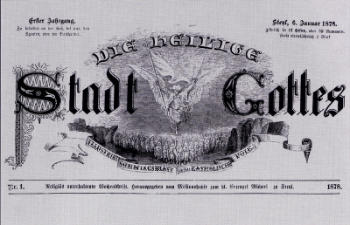
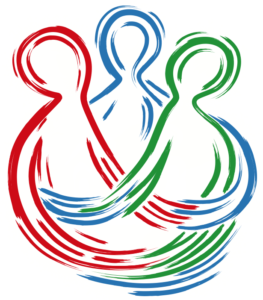

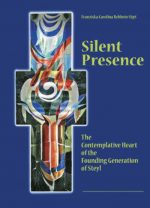
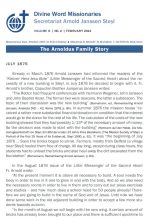
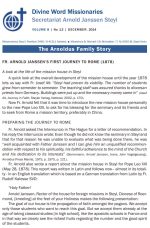
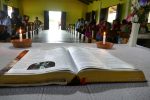
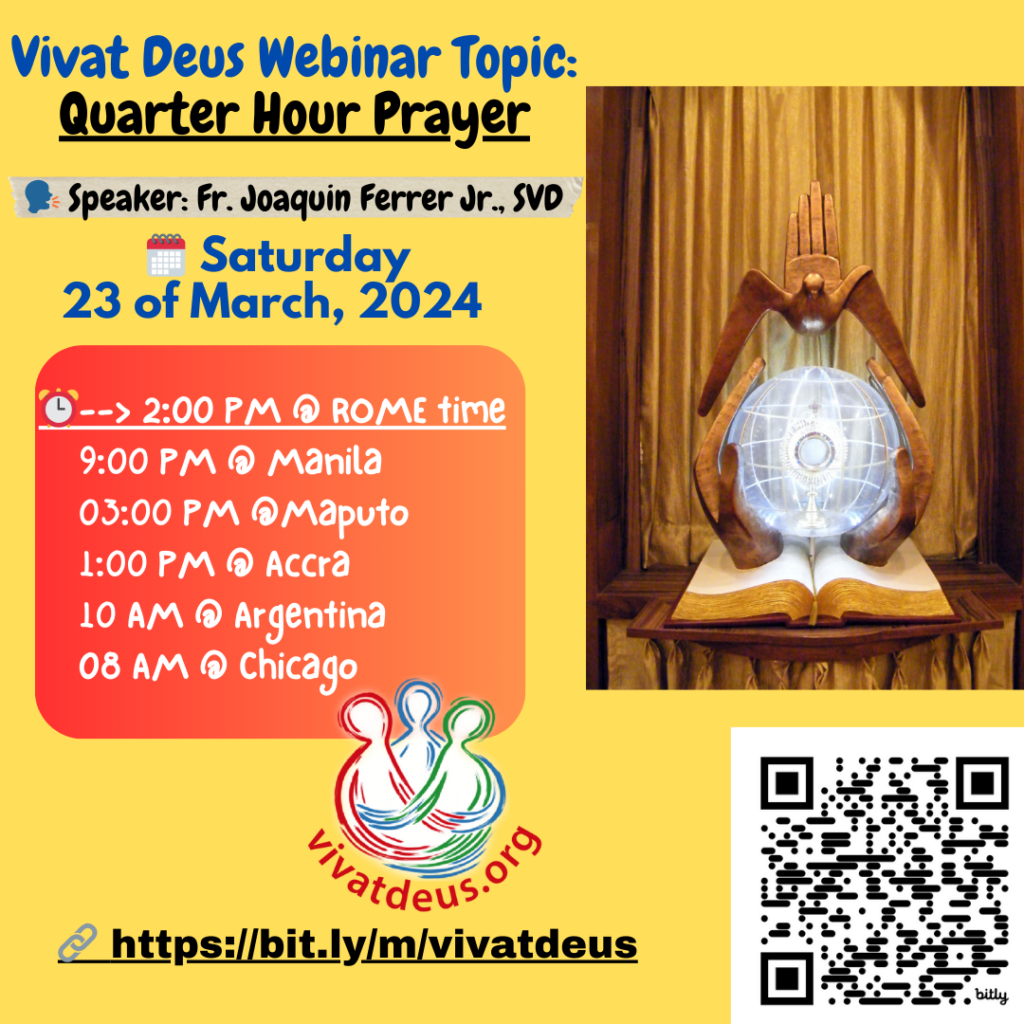
One Response
Muy buen resumen del tema! En las biografías de san Arnoldo se puede encontrar una opinión que san Arnoldo no era buen predicador. Tal vez no era muy teatral en sus gestos y rebuscado en sus palabras, pero era un buen comunicador. Ante todo, porque tenía unos fines claros y una honestidad ejemplar a la hora de dar cuentas de la realización de los mismos a los lectores.